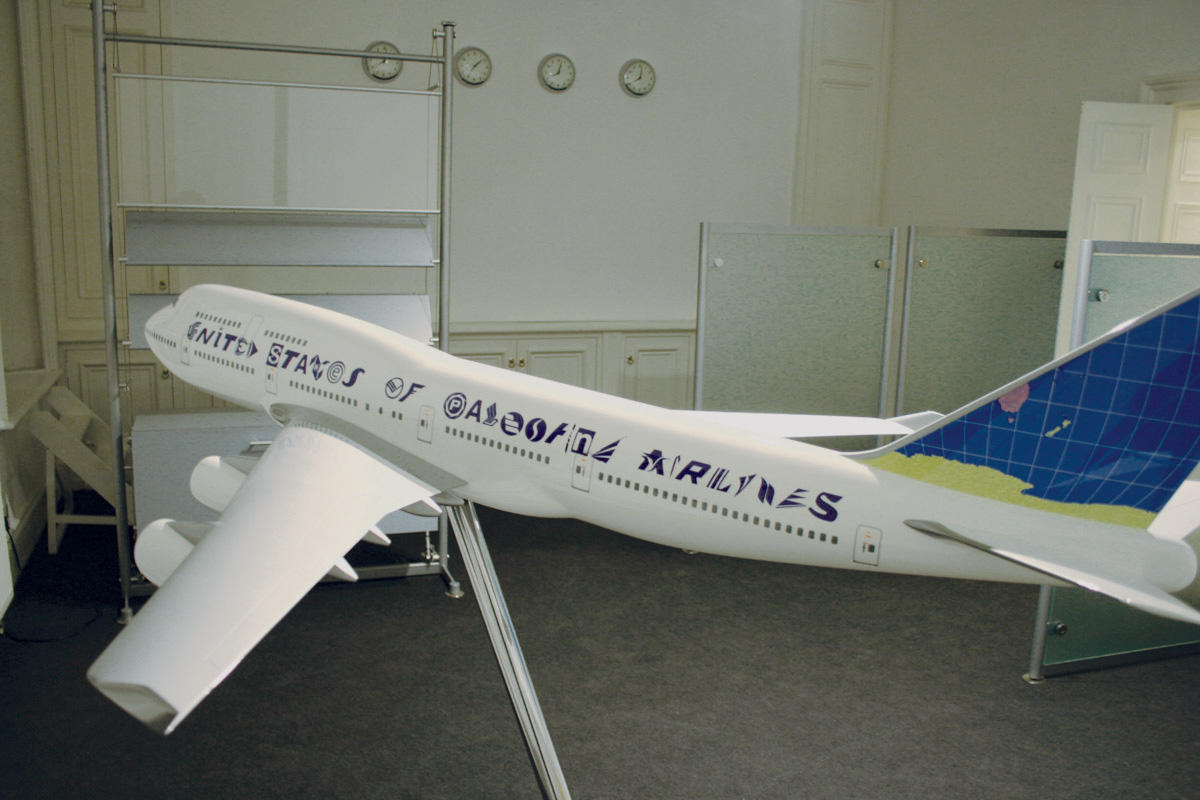
London
Khalil Rabah
Artists’ Studio
March 13–April 15, 2007
West London’s Knightsbridge area isn’t known for its contemporary art spaces; visitors to this affluent district are more likely to be doing a spot of designer shopping or taking in one of the many embassies and international cultural institutions in the surrounds. Artists’ Studio, located in a Victorian house in this neighborhood, is a temporary project space on loan from a benefactor. Over the course of a year, seven artists have been invited to develop projects that “undermine or interface with the space of the apartment or studio.”
Khalil Rabah’s recent exhibition at Artists’ Studio seemed particularly fitting given the area’s institutional tenor. Consisting of one work, the hypothetical office of a United States of Palestine Airlines, the installation was an offshoot of Rabah’s own established “institution,” the fictional Palestinian Museum of Natural History and Humankind. (It followed the presentation of 50,320 Names, an installation at the School of Oriental and African Studies’ Brunei Gallery.)
The United States of Palestine Airlines had just become a sponsor of the Palestinian Museum of Natural History and Humankind in an agreement, we were told, worth £2.5 million over five years. The museum director — Rabah himself — is thrilled. “The sheer size and scale of this deal is an amazing opportunity for us,” ran the quote in the museum’s newsletter. “We are delighted to have Palestinian Allied Airlines [sic] as our sponsor.” Naming rights to a new gallery in the museum, of course, was one of the conditions of the lucrative deal. The letters of the fictional airline’s logo were made up of the logos of existing national airlines. (Some were easily recognizable, some less so — world travelers visiting the exhibit had the advantage.)
The airline’s office looked fully functional, and the aesthetic was clean, simple, and subdued. The components of the corporate feng shui within the confines of the space included a sofa, some glass and metal barriers, an enlarged version of the type of model airplane you might find in a travel agency, a map of the world emblazoned with the company logo, and three clocks in a line on the wall, two of which gave the same time. The overall sense was of entering a brand-new office where the staff had yet to move in. As a visitor in the role of faux-client, I felt as though I might have arrived too early.
Rabah is a veteran of the art scene in Palestine, and his project at the Artists’ Studio was a continuation and extension of the Palestinian Museum of Natural History and Humankind — exhibited in 2005 at the Istanbul Biennial, among other venues — and developed further its fictional scenario. Indeed, the work’s raison d’être was dependent on the museum and required some knowledge of that project, and of Rabah’s oeuvre in general, to be really effective. Rabah’s work falls within the lineage of such museological projects as Marcel Broodthaers’s Museum of Eagles or, more recently, the work of Mark Dion, who tends to use idiosyncratic and parodic archiving and display as a strategy for critiquing art institutions. But Rabah’s work casts a decidedly wider geopolitical net.
Compared to the substantial Palestinian Museum project, however, Rabah’s United States of Palestine Airlines appeared more limited in scope, reflecting solely on the issue of restricted mobility. The link to the museum through the idea of patronage seemed a little simplistic and could well have been explored in greater depth. Mobility is, of course, a constituent of cultural freedom; as obvious as this may seem, it is certainly worth considering in an exhibition context. However, the installation as ultimately configured felt like little more than the sum of its parts. Like most West End galleries, the Artists’ Studio tends to attract almost exclusively an art world audience; the unrealized potential relationship between the fictional airline and the local environment accentuated this, leaving the viewer with a taste of a hermetically sealed office that seemed to speak to just a few “clients” in the know.